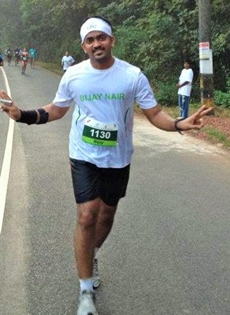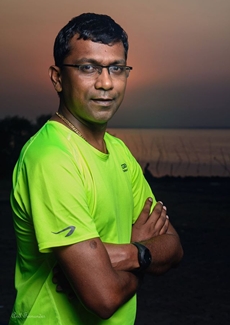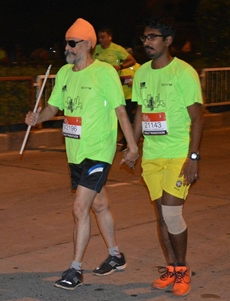Incredible people
23 Jan 2017
Bijay Nair was a commissioned Naval Officer from the Naval Academy and served for 10 years before taking a voluntary retirement as a Lieutenant Commander. Currently working for the National Ship Classification Society as a Marine Surveyor, he is an engineer and an MBA, with a passion for marathoning and writing humour. Though running was a part of his naval academy regime, his tryst with marathon running commenced soon after being diagnosed with thyroid disorder in 2008 with a body weighed over 100 kilos. In the last eight years he has participated in seven full marathons (42 km), 36 half marathons (21 km) in 13 countries.
Lt Cmdr Bijay Nair (retd)
In this interview with Swetha Amit, Lt Cmdr Nair narrates how interviewing 42 marathoners for his book They INSpire changed his own perspectives in life. Also in conversation are Samuel Chettiar, a fourth-stage cancer survivor and Amarjeet Singh Chawla, who lost his eyesight to the onset of macular degeneration from the age of 13 who narrate their experiences of overcoming their respective challenges and why they found solace in running as a sport.

They INSpire is a collection of 42 stories of some awe-inspiring individuals who are runners. So what really inspired this book?
Lt Cmdr Nair: One evening in 2015 when I was randomly browsing through Facebook, I came across several runners who posted their updates about the mileages that they had run on that particular day. I then realised that I knew runners who have run humongous distances like 100 km and yet don't share their stories on social media. It instantly gave me an idea that I should highlight the experiences of such accomplished runners. My first story started as a small snippet about a guy called Mumtaz Quereshi who despite being a busy corporate professional at Tata, managed to find time to run irrespective of his hectic schedules. This story became a big hit on social media and that's how I decided that perhaps I could pen down a book of several such stories of corporate professionals who find time to run and keep fit despite their erratic schedules.
I chose the title They INSpire as this book was a compilation series of other people and the alphabets 'INS' was a tribute to my Indian Navy background. Since my book consists of stories of people in the corporate world who find time to run despite their busy schedules, I thought this book would inspire other corporate professionals who often complain about not being able to find time to pursue other interests.
Considering that the running community is large, what made you choose these 42 particular individuals as protagonists for your book?
Nair: The first criteria, which I had set while writing this series was to tell people that there are individuals who have taken to running and fitness despite abusing their bodies by excessive smoking or succumbing to a dreadful illness. The second was that all these people covered in the book should personally be known to me so that I could retain the authenticity. For instance, when I asked them questions, I knew for a fact that what they were saying was true. The third criteria was to represent a varied demography of people right from couples, youngsters, senior citizens who took up running post the age of 60 to differently-abled individuals. The message which I wanted to give through this book was that running is an equal sport where several individuals from varied backgrounds run together.
Today a lot of corporates and banks are associating themselves with marathon events. So why do you think a sport like running has caught the fancy of these organisations as compared to other sports?
Nair: Long distance running is a sport, which unearths the two vital and important aspects of what a corporate looks for in an individual.
One is the limits which the individual places upon himself / herself as a challenge. You see marathon running is not just about running on the race day. It requires immense amount of discipline, planning and preparing a training schedule accordingly. It also involves root cause analysis of your performance and the necessary corrective & preventive actions to be taken to improve your performance further. This is similar to what takes place in an organisation with regards to an individual's performance and increasing productivity.
The second important aspect is that marathon as a sport inculcates that sense of team work and team building for an individual. When you are running a race / training in a group, you are running with several other people from varied backgrounds. You tend to encourage and motivate one another during the run to help in achieving the target which is the finish line of the run / race. This instills the aspect of motivation and team work which are important aspects of the corporate world.
Writing about several awe inspiring individuals cum fellow runners can be quite a riveting experience. So what were your learnings while penning down this book?
Nair: Writing this book was a humbling experience as I got to know these 42 individuals even deeper. A few of them were my really close friends and hence I knew them very well on a personal level. Though others were good friends as well, I would only meet them on a run and didn't get much of an opportunity to get to know them at a deeper level. Interviewing them for my book enabled me to get to know them better and also appreciate each one of them for their abilities. The women especially have to juggle between several commitments yet still make time for their runs.
What can we expect next from you? Any more books in the pipeline?
Nair: Yes, in fact, I am already working on a few ideas. Since humour is my forte I am trying to write a book on humour which will be a compilation of my blog since the last five years. My condition and criteria for this book is that I should be able to laugh out loud while reading my own book. I really enjoy writing, keeping people engaged and evoking a response out of them. So I am hoping that this book works. And of course They INSpire-part 2 is on the cards as well which will release after my book on humour stories.
Samuel Chettiar
Samuel Chettiar, A fourth-stage cancer survivor and a fighter, is the regional (sales) manager for Schneider, extremely busy and travels most of the time. And yet, he is a passionate runner. An awesome runner-photographer, Samuel's story has been aired and featured in almost all the papers and TV channels. Sam is always ready to counsel anyone or the family of someone undergoing cancer trauma. 
Sam, your story from being a stage 4 cancer patient to running full marathons is quite an inspiring journey. Could you tell us what made you choose a sport like running over other sports like say mountaineering?
Chettiar: Well running was not something that I purposefully chose. It happened by default. I had finished my treatment sometime in 2009. Due to the side effects of chemo therapy and sedentary lifestyle, I started putting on weight and in 2012, the scales hit a good 86 kg - the highest I have been in my life. Along with the weight gain, I started facing some health issues like high cholesterol levels. Now since I had come out of a dreadful health issue, I did not want to enter into another one and hence joined the gym in December 2012. The gym routine was accompanied with a strict diet regime. During one of the gym sessions, somebody recommended road running over treadmill running and that's how I started my tryst as a road runner. I started with 10km and then slowly graduated to a half marathon and now I am doing full marathons across the globe.
I used to play a lot of other sports back in school and college. As a part of cross training for running, I still play a lot of football even now.
How did it feel to take up another challenge after overcoming one in your life?
Chettiar: Running a marathon is certainly a challenge. In fact, one of the most challenging days of my running career was my first day. I was drained out after running 800 m. What kept me going was the fact that I was primarily doing this for my well-being. This kept me going and I gradually managed to move from running 800 m to a full marathon. If someone asks me what was the most important thing that got me to a full marathon, I would attribute it to consistency. This consistency factor helped me overcome the challenges and better myself over time. In order to run, you have to be consistent with your training.
How do you think running has changed your life over the years?
Chettiar: Well I initially never had a passion for anything until I started running. Now running has become my passion. It gives me joy, a sense of fulfillment and it takes me to a zone of happiness that no money can buy. It's a new way of life for me as it breaks the monotony and the routine that we are accustomed to in our daily lives.
Speaking of monotony, a lot of people tend to find running monotonous. Since you have always kept yourself going, how do you think people can keep themselves motivated to continue running?
Chettiar: Now that is something subjective and varies from person to person. What I normally recommend to people is to join a group. That way, the motivation levels are high and people feel inspired to get out and hit the roads. Team work and effort keeps the interest and motivation levels high as it also involves the social and connectivity factor. Running alone can at times get monotonous and make a person lose interest in it quickly.
 | |
| Amarjeet Singh Chawla |
Despite being visually challenged, your running prowess is an admirable feat. What made you choose a sport like running over other sports?
Chawla: I was 13 when I was diagnosed with Macular degeneration. By the time I was 40, I wanted to do something that would make me stand out from the crowd. One day, I received a message on my mobile from the National Association for the Blind (NAB) to run for the blind in the first edition of the Standard Chartered Mumbai Marathon which was in 2004. I immediately went to the NAB office where they allowed me to run the dream run which was about 7km. I was 48 then. After that I slowly increased my distances and eventually got hooked to running. In fact in the last three - four years I have become very addicted to running as a sport. I have run a lot of races in and around Mumbai and have even run an ultra-marathon, accompanied by an escort.
I am a mountaineer as well and I have done a lot of treks in the Himalayas such as Chandrakhani Pass Trek and Valley of flowers. In fact I am the only visually challenged person to climb the Doma La Pass at 19,500 feet. However trekking can be time consuming and expensive. In comparison to this, running seemed to be an economical sport.
Could you tell us more about your condition and how did you initially feel when you were diagnosed with this?
Chawla:I suffer from Macular degeneration-a leading cause for vision loss which is incurable. Macular Degeneration is caused by the deterioration of the central portion of the retina. For about 2-3 months initially, I refused to go out and confined myself to my house. I was then encouraged by my wife to start moving out a bit as life had to go on. At that time I was partially blind and gradually to lose vision. By the time I lost my entire eyesight, I was mentally adapted to this condition.
How do you think running has changed your life?
Chawla: I was first an introvert but now I have opened up a lot more. The good thing is that people cheer for me and I feel very happy about it. I feel that if I can inspire at least 2 people to take up running then I feel that my whole purpose of running will be fulfilled even more. Right now I am targeting to run 101 half marathons and my quest for running will only keep increasing as time goes by.
(See book excerpt: Excerpt from They INSpire )







.webp)














